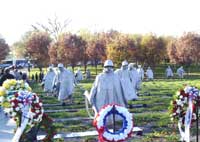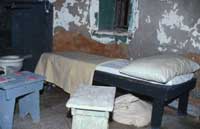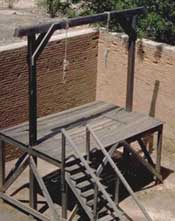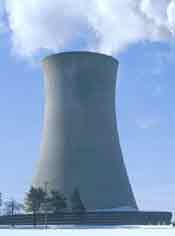
hopes that they will abandon their nuclear
weapons program.
Of all the world’s problematic regimes, North Korea certainly ranks among the worst. This has been manifested recently in their tests of long-range missiles and nuclear arms, both of which are forbidden under current agreements with the rogue nation.
On a more personal note, the recent arrest and sentencing of American journalists Laura Ling and Euna Lee is yet another provocation against the U.S.
These two journalists were sentenced to twelve years hard labor. Their only alleged crime is having wandered across the border from China into North Korean territory while investigating the trafficking of women from that regime into its totalitarian neighbor.
However, many doubt that the two ever crossed into the forbidden territory and consider this to be a case of kidnapping. Thus, even the New York Times admits: “The exact circumstances of their arrest remain unclear.”
Most likely, the journalists will be used as a bargaining chip for the regime to gain more favors from the West and will never serve in a North Korean labor camp. However, this is not certain. Moreover, their sentence sheds light on the country’s little-known system of gulags.
The fact is that North Korea continues to enslave over 200,000 people in a harsh regime of persecution, mistrust and utterly sub-human treatment.
The communist government has gone to great lengths to conceal full knowledge of this reality. Nevertheless, a 2003 study made by David Hawk and published by the U.S. Committee for Human Rights in North Korea, titled The Hidden Gulag Exposing North Korea’s Prison Camps sheds some light on the grisly reality of what occurs inside the gulags.

Kwan-li-so (Political Detention Center)
The study uncovers a hidden system of huge penal labor colonies, twenty or more miles long and ten to twenty miles wide, in which 200,000 North Koreans toil for up to fifteen-and-a-half hour days, on food rations so meager that prisoners remain in a state of semi-starvation, forcing them to forage for anything that could be considered edible: snakes, rats and even grass.
Semi-Starvation
With hard work days, in some cases exceeding 15 hours of manual labor, the body naturally requires a healthy and substantial diet. However, in North Korea’s gulags, daily food rations range from 16 oz of rice and beans to only 20-30 kernels of corn and some watery cabbage soup. One former inmate reports that the farm animals ate better than he did.
The effects of hard labor coupled with lack of sufficient sustenance has awful effects on the prisoners’ bodies. One former detainee claims that the prisoners he saw upon entering the prison camp looked like walking skeletons.
Many are incapable of sustaining these conditions and die of malnutrition or other starvation-related illnesses. In what Mr. Hawk named Kwan-li-so No. 15 “Yodok,” in the South Hamgyong Province, one former prisoner Dang Chol Hwan estimated that 100 prisoners out of a total population of 2,000-3,000 died each year from malnutrition. In other prisons, the annual starvation-related death toll soars to 200.
Former detainee Lee Young Kuk lost 80 pounds in the four years he spent quarrying stones for fourteen hours a day. At another Kwan-li-so, former prisoner #12 — who asked that his identity remain secret — lost 100 pounds in four years, leaving him at a mere 77 pounds.
Psychological Torture
In addition to starvation, prisoners must endure constant and intense psychological torture. While this varies in degree and kind from prison to prison, intense psychological punishment is administered at all the detention facilities that the study describes.
One of the more shocking forms of psychological torture is the so-called “collective responsibility” (yeon-jwa-je). Under this system, the communist regime imprisons up to three generations of a “malefactor’s” innocent family members. A 1972 statement of Kim Il Sung (North Korea’s “Great Leader”) is the basis for this practice. In it, he stated: “Factionalists or enemies of class, whoever they are, their seed must be eliminated through three generations.”
Prisoners are also forced to witness public executions for the most frivolous offenses.

Public Execution
In Kwan-li-so No. 14, Kim Chul Min was executed because, driven by hunger, he collected some ripe chestnuts that had fallen from a tree in the prison compound.
When Kal Li Young stole a leather whip and attempted to soften it with water to eat it, a guard smashed his mouth with a feces-covered stick. He was also executed.
In some cases, the prisoners are expected to do more than just watch their companions’ deaths. Former prisoner Lee Young Kuk reports on the execution of an attempted escapee, Hahn Seung Chul, who was pulled behind a car until his death, at which time the prisoners were ordered to place their hands on his bloodied corpse. When one prisoner, Ahn Sung Eun, shouted out in protest he was shot to death.
Mr. Lee also witnessed a public execution by firing squad, after which, the prisoners were obliged to throw a stone at the deceased man’s corpse.
Criticism Sessions
Prisoners must also attend “criticism sessions,” in which everyone in the prison is obliged to confess their own faults and those of others. The sessions do not end until every prisoner has confessed something. In some prisons, there are small incentives to spy and report on fellow prisoners.
In addition to criticism sessions, there are reports of prisoners forced to beat each other. This creates an atmosphere of distrust and resentment among the prisoners, stifling the companionship which would otherwise lighten the load of their torments.
Physical Torture
Prisoners of the Kwan-li-so are not only submitted to psychological tortures, but physical ones as well. Prisoners are beaten, stuffed into undersize “punishment boxes” so small they can neither sit nor stand. Others are submitted to water tortures, in which they are repeatedly partially drowned. They are forced to remain motionless for up to six days, hung up by their wrists with their feet off the ground and obliged to stand-up/sit-down to the point of collapse.
Forced Abortions
Perhaps the most heinous aspect of North Korean gulags is their system of forcibly aborting the children of pregnant women who are repatriated from China to ensure that half-Chinese are not born to Korean mothers.
Forced abortions are used only for those women who are in the beginning stages of their pregnancies. If the woman has almost come to term, labor is induced. After birth, her child is murdered before her eyes.
Some of these children are suffocated with wet vinyl; others are discarded into a box that is buried when full. These boxes are often buried with some of their occupants still alive.
The number of such murders is high because it is common for women to return pregnant from China. Some are eager to marry only after escaping North Korea. Many others are trafficked to ethnic Chinese men.
Mr. Hawk relates the grisly details of a 66 year-old woman incarcerated for trying to flee to China. Deemed too frail to work in the prison’s rice fields, she was taken to a nearby medical clinic to work as a mid-wife. After helping deliver four children — two full-term and two premature — they were discarded into a box. The study then states:
Two days later, the premature babies had died but the two full-term baby boys were still alive. Even though their skin had turned yellow and their mouths blue, they still blinked their eyes.
The agent came by, and seeing that two of the babies were not dead yet, stabbed them with forceps at a soft point in their skulls. Former detainee #24 says she then lost her self-control and started screaming at the agent, who kicked her so hard in the leg that she fainted.
Concerning a different detention facility, the study relates:
When the babies were born, they were placed face down on the ground. Some babies died right away; others lived longer. If any babies were still alive after two days, the guards would smother them with wet vinyl. The babies lying on the ground could be seen by the women standing at the front of other cells. The guards would say that the mothers had to see and hear the babies die because their babies were Chinese.

Carrying a Big Stick
North Korea has demonstrated that it is unwilling to accept talks or reason. It is irresponsive to appeasement and refuses to honor treaties. For the sake of its enslaved population, it is time to rethink our policy of appeasement and take steps to bring down this evil regime.
The U.S. must use all its influence to stop the countries who still trade with North Korea. Eagerness to enrich oneself is hardly an excuse to capitalize on the cheap labor of those who slave in these compounds. Removing demand for North Korean products would increase the strain on the country’s teetering economy and weaken its government.
Second, North Korea should be forced to suspend immediately its nuclear weapons and missile programs. North Korea has already demonstrated a willingness to subsidize its strained economy with terrorist dollars in exchange for nuclear technology.
The U.S. should immediately return North Korea to the list of terrorist states. It should give North Korea an ultimatum backed up by the threat of force.
America should also bring every diplomatic effort to bear on North Korea to immediately stop all human rights violations. Together with Cuba, it should be the object of a high-priority human rights campaign.
This is the least America can do to ensure the safety of its local allies and cut off the spread of nuclear technology to Middle Eastern states that threaten U.S. soldiers. Building upon the words of Teddy Roosevelt, America has tried walking softly for too many years, it is time to bring out the big stick.

